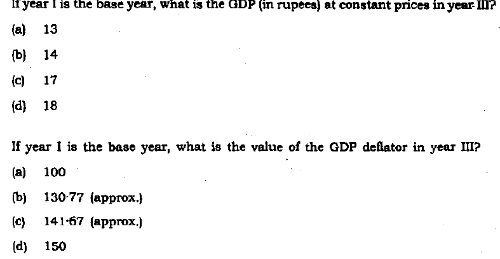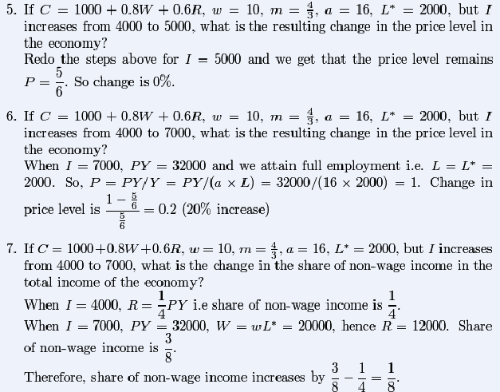JNU ECOM 2011 QUES 11-22 {Must see}
JNU ECOM 2011 QUES 11-22 {Must see}
|
This post was updated on .
QUES11
 Answer-  QUES 12  Answer-b QUES 13,14  Answer 13-a 14-d QUES 15 What is the rate of growth of real GDP (base year I) in year III? a. 10% b. 13.67 % c. 18.18 % d. 20 % Answer-d Questions 16-22 are to be answered on the basis of following information: Let Y: aggregate real output per year P: the price level C: money value of aggregate consumption expenditure per year I: money value of aggregate investment expenditure per year L: aggregate employment (in labour hours per year) L*: total labour supply (in labour hours per year) w: hourly money wage rate Let W denote the money value of aggregate wage income per year, R the money value of aggregate non-wage income per year. Consider an economy in which labour is homogenous, the aggregate producitivity of labour (Y/L) is a constant a and the price level (when output is below its full employment level) is a factor m times the wage cost per unit of aggregate output . The price at full employment is always greater than or equal to that at below full employment. In equilibrium , PY= C+I QUES 16 If I = 4000, C = 1000+0.8W+0.6R, w= 10, m= 4/3, a=16, L*=2000. What is the full employment level of output in the economy? a. 125 b. 625 c. 24000 d. None of the above Answer-d QUES 17 If C = 1000+0.8W+0.6R, w= 10, m= 4/3, a=16, L*=2000, and output is below its full employment level, what is the increase in nominal income per unit increase in investment expenditure in the economy? a) 2 b) 4 c) 8 d) 16 Answer-b QUES 18 If I = 4000, C = 1000+0.8W+0.6R, w= 10, m= 4/3, a=16, L*=2000. what is the price level in the economy ? a) 0.83 (approx) b) 0.93 (approx) c) 1.07 (approx) d) 1.16 (approx) Answer-a QUES 19 If I = 4000, C = 1000+0.8W+0.6R, w= 10, m= 4/3, a=16, L*=2000. what is the fraction of total labour supply which remains unemployed in the economy? a) 5% b) 10% c) 12.5 % d) 25% Answer-d QUES 20 If C = 1000+0.8W+0.6R, w= 10, m= 4/3, a=16, L*=2000, but I increases from 4000 to 5000, what is the resulting change in the price level in the economy? a) 0% b) 5% increase c) 10% increase d) 20% increase Answer-a QUES 21 If C = 1000+0.8W+0.6R, w= 10, m= 4/3, a=16, L*=2000, but I increases from 4000 to 7000, what is the resulting change in the price level in the economy? a) 0% b) 5% increase c) 10% increase d) 20% increase Answer-c QUES 22 If C = 1000+0.8W+0.6R, w= 10, m= 4/3, a=16, L*=2000, but I increases from 4000 to 7000, what is the change in the share of non-wage income in the total income of the economy? a) No change b) increases by 1/8 c) increases by 1/6 d) increases by 1/5 Answer-b |
Re: JNU ECOM 2011 QUES 11-22 {Must see}
|
Help with ques 11,13,14,15
|
Re: JNU ECOM 2011 QUES 11-22 {Must see}
|
In reply to this post by Arushi :))
I am attaching these solutions provided by sir for question 16-22
Ques 16 aL*= 16x2000= 32000. Therefore, d is the answer Because Y/L is a constant a Ques 17  Ques 18,19  Ques 20,21,22 
|
Re: JNU ECOM 2011 QUES 11-22 {Must see}
|
In reply to this post by Arushi :))
I am getting these answers for questions 13-15.
13. 23 14. 160.87 15. 21.05 These are not there in the options. Maybe, you too are getting the same answers. I think the questions are wrong (We got the right answer for question 12. So our method is not wrong). If anyone gets some other answer, please share. |
Re: JNU ECOM 2011 QUES 11-22 {Must see}
|
Okay so I found my mistake :D
Didn't read the para , just saw the table ! Its given only X & Y are final goods , so only they should be included in GDP calculation! So, my answers are 16.5, 18, 150 and 20% Someone verify |
Re: JNU ECOM 2011 QUES 11-22 {Must see}
|
And ques 11

|
Re: JNU ECOM 2011 QUES 11-22 {Must see}
|
In reply to this post by Arushi :))
I too didn't read the para.
I think the answer for question 11 is option D None of the above Since equilibrium income is 1750, which is above 1500, consumption function is valid only upto 1500 units. The remaining 250 is saved (invested), since S=I. Of the 1500, 200+0.6*1500=1100 units are consumed. Remaining 400 units are also invested (saved). Aggregate consumption= 1100 Aggregate investment = 650 So, the value of investment required is 650, which is corresponds to option D. I am not entirely sure of my answer. Please come up if you have a better answer. |
Re: JNU ECOM 2011 QUES 11-22 {Must see}
|
Ibrahim is correct.....the ans is option D
Akshay Jain
Masters in Economics Delhi School of Economics 2013-15 |
|
In reply to this post by E A Ibrahim
Yup, I got the same thing!
|
Re: JNU ECOM 2011 QUES 11-22 {Must see}
|
In reply to this post by Arushi :))
12 . GDP at current price=pxqx+pyqy
1.5*3+2*6 16.5 13. GDP at constant price= 6*1+6*2 18 14. GDP defaltor= nominal gdp/real gdp 6*1.5+3*6/18 150 15. rate of growth=real gdp3-real gdp2/real gdp2 18-15/15*100 20% |
«
Return to General Discussions
|
1 view|%1 views
| Free forum by Nabble | Edit this page |

